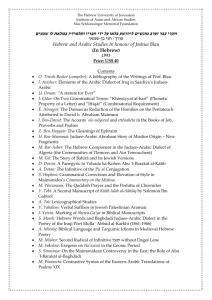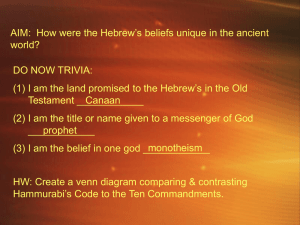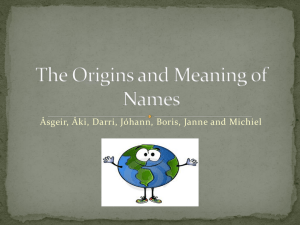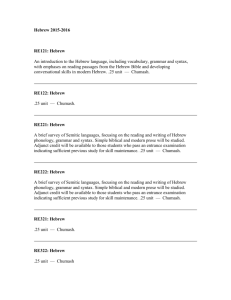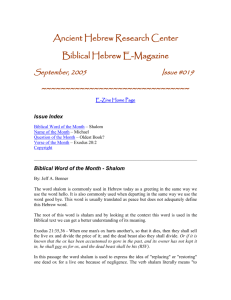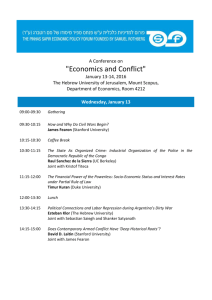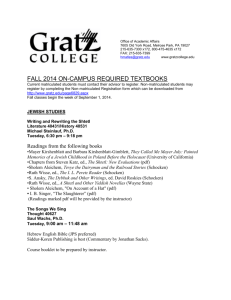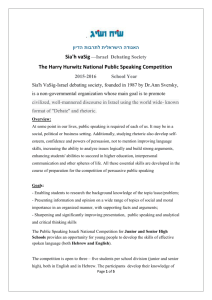Biblical Hebrew E-Magazine - Ancient Hebrew Research Center
advertisement
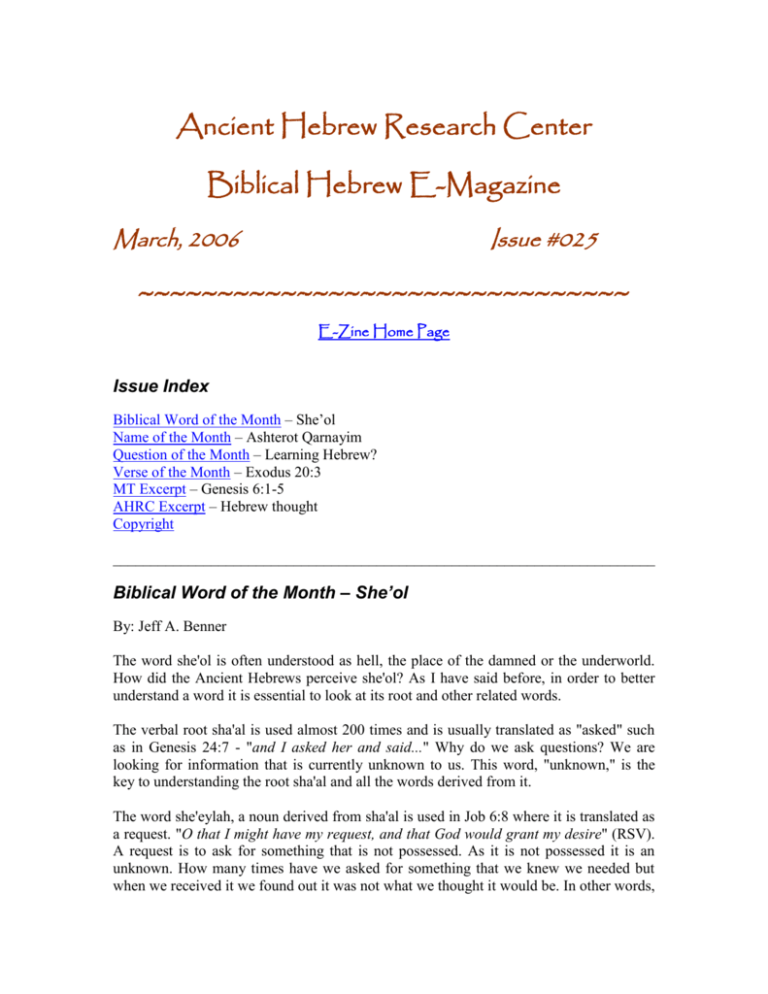
Ancient Hebrew Research Center Biblical Hebrew E-Magazine March, 2006 Issue #025 ~~~~~~~~~~~~~~~~~~~~~~~~~~~~~~~ E-Zine Home Page Issue Index Biblical Word of the Month – She’ol Name of the Month – Ashterot Qarnayim Question of the Month – Learning Hebrew? Verse of the Month – Exodus 20:3 MT Excerpt – Genesis 6:1-5 AHRC Excerpt – Hebrew thought Copyright ________________________________________________________________________ Biblical Word of the Month – She’ol By: Jeff A. Benner The word she'ol is often understood as hell, the place of the damned or the underworld. How did the Ancient Hebrews perceive she'ol? As I have said before, in order to better understand a word it is essential to look at its root and other related words. The verbal root sha'al is used almost 200 times and is usually translated as "asked" such as in Genesis 24:7 - "and I asked her and said..." Why do we ask questions? We are looking for information that is currently unknown to us. This word, "unknown," is the key to understanding the root sha'al and all the words derived from it. The word she'eylah, a noun derived from sha'al is used in Job 6:8 where it is translated as a request. "O that I might have my request, and that God would grant my desire" (RSV). A request is to ask for something that is not possessed. As it is not possessed it is an unknown. How many times have we asked for something that we knew we needed but when we received it we found out it was not what we thought it would be. In other words, Biblical Hebrew E-Magazine we thought we knew what we were missing but it turns out that what we were requesting was an unknown. The word she'ol, also derived from sha'al, was understood as the place where one goes when they die. The question is, did they understand this to be simply the grave one is buried in or another place one goes after they die? This is a difficult question to answer as the Hebrew Bible never really defines she'ol. There is evidence however that they understood it to be more than just the grave. First, the word qever is the Hebrew word meaning grave and therefore it is possible that she'ol was understood as something other than the grave. Second, most scriptures using the word she'ol imply a place other than the grave. An example is Genesis 37:35 All his sons and all his daughters rose up to comfort him; but he refused to be comforted, and said, "No, I shall go down to Sheol to my son, mourning." Thus his father wept for him (RSV). In this account Jacob believed his son Joseph had been eaten by a wild beast. As Joseph's body could not possibly be in a grave, Jacob knew that he would be with him somewhere - she'ol. The Ancient Hebrews did not know where or even what she'ol was. To them it was an unknown place hence, the use of a word related to sha'al meaning "unknown." It should also be noted that the Ancient Hebrews never speculated on something unknown, it was simply not known and left at that. It is only the Greek mind that desires to know the unknown. It is our Greco-Roman western mindset that needs to know where and what she'ol is. ________________________________________________________________________ Name of the Month - Ashterot Qarnayim By: Jeff A. Benner This place name only occurs once in the Hebrew Bible - Genesis 14:5. It is composed of two words the first being Ashterot (ash-te-rot). The "ot" is the feminine plural suffix, the singular form is Ashter meaning "the young one of the flock," the plural form Ashterot meaning "young ones of the flock." This is also the name of the Canaanite goddess as seen in Judges 2:13. This same goddess was called Ishtar in the Babylonian mythology and is the origin of the word "Easter". The word Qarnayim (qar-nah-yim) is also a plural word, the singular form being qeren meaning horn. The Hebrew word qeren is the origin of our English word crown. In ancient times a crown was made of "horns" and the pointed tips of the crowns we are familiar with today represent those horns. The word qeren is also a feminine word and its plural form is qarnot. Notice that the plural form of the word Qarnayim uses the "yim" suffix instead. The "yim" suffix is what is called the dual plural and is used for things that come in pairs such as hands (yadyim) or ears (az'nayim). The word qarnayim then means "two horns". 2 Biblical Hebrew E-Magazine When these the two words, Ashterot Qarnayim, are combined we have the meaning "the young ones of the flock of the two horns." _______________________________________________________________________ Question of the Month – Learning Hebrew? By: Jeff A. Benner Q: Will I better understand the Bible by learning Hebrew? A: There is no argument that reading any work in its original language will provide a better understanding of that text. For instance, to really understand the works of Martin Luther it is best to read it in German and the works of Plato in Greek. This also applies to the Hebrew of the Tenach/Old Testament. Just as one example the phrase "sha'alu shalom yerushalam" is translated as "pray for the peace of Jerusalem" but much of the Hebraicness of the verse is missing. The word sha'alu is the verb sha'al meaning to ask or make a request and the suffix "u" identifies the subject of the verb as plural. The word shalom more specifically means completeness or to be in health and prosperity. The name Yerushalem is a combination of the word Yeru meaning teach. Shalem which is identical to shalom meaning completeness. The full Hebraic understanding of this verse is "All of you make a request that the ones who teach shalom/completeness will be given health and prosperity." It should also be understand that learning Hebrew will not always bring out the original intended meaning of a word or phrase. The problem is that we think from a western perspective and this is also true for those who speak Hebrew today. For instance the word tsadiyq is usually understood as "righteous" as identified in all modern lexicons and dictionaries of the Biblical Hebrew language. While we are comfortable using abstracts in our modern western minds, the Ancient Hebrews always understood things through the concrete. The word original concrete meaning of tsadiyq "to remain on the correct path". In summary, learning Hebrew will enhance ones understanding of the Biblical text but the Hebrew must be learned through ancient Hebraic mind and not the modern Hebrew mind. ________________________________________________________________________ Verse of the Month – Exodus 20:3 By: Jeff A. Benner ֹלהים אֲ ֵח ִרים עַ ל־ ָּפ ָּנ ַי ׃ ִ ֱל ֹא י ְִהיֶה־לְ ָך א Thou shalt have no other gods before me. (ASV) 3 Biblical Hebrew E-Magazine ( ל ֹאlo) This word means "no" or "not" and often precedes a verb to negate the action of that verb. ( י ְִהיֶהyih-yeh) The base word is ( היהhayah) meaning "to exist." The prefix ( יy) identifies the subject of the verb as third person, masculine and singular (he) and the tense of the verb as imperfect. This word would be translated as "he exists." ( ְלָךle-kha) The ( לl) is a prefix meaning "to" or "for." The ( ךk) is a suffix meaning "you." ֹלהים ִ ֱ( אe-lo-hiym) The base word ( אלוהe-lo-ah) is commonly translated as "God" or "god," but more literally means "one of power and authority." The suffix ( יםiym) is the masculine plural. This noun is the subject of the verb ( היהhayah), the "he" of "he exists." ( אֲ חֵ ִריםa-hha-riym) The base word is ( אחרa-hher) meaning "other" or "another." This is an adjective describing אלהים. The gender and number of any adjective will match the noun it describes; therefore the same plural suffix is added to this adjective. ( עַ לal) This is a very common word meaning "over" or "above." ( ָּפ ָּנ ַיpa-nai) The base word is ( פנהpanah) meaning "face". But also includes two suffixes, ( יםiym) the masculine plural suffix and ( יy) the first person possessive pronoun meaning "of me." In order to explain the formation of this word let me write this word as י-ים-( פנהpanahiym-iy). When a suffix such as ( יםiym) is added to a noun ending with the letter ( הh), the הis dropped so now we have י-ים-( פנpan-iym-iy). When a plural noun is suffixed with a possessive pronoun such as the ( יy), the ( םm) is dropped so now we have י-י(פנpan-iy-iy). The two יs are then combined into one and pronounced "ai" (like the "i" in bike) – ( פניpan-ai). This Hebrew word meaning "face" is always idiomatically written in the plural form but should not be understood as more than one face. The following is a literal rendering of this verse from its Hebraic meaning. Other ones of power and authority will not exist over my face. 4 Biblical Hebrew E-Magazine ________________________________________________________________________ Mechanical Translation Excerpt - Genesis 6:1-5 1. and it came to pass that the human caused to pierce to increase in number upon the face of the ground and caused to give birth to daughters for them 2. and the sons of the powers saw the daughters of the human that they were functional and took for them the women from which they chose 3. and YHWH said my wind will not moderate in the human to an ancient time whereas he is flesh and his days will exist a hundred and ten years 4. the Nephilim existed in the land in the days of them and also after so which the sons of the powers come to the daughters of the human and they gave birth to them, they are the courageous ones which are from an ancient time, men of the character 5. and YHWH saw that the dysfunctions of the human in the land were abundant and all the thought of inventions of his heart were only dysfunctional all the day For details on this new translation see the web site at http://www.mechanical-translation.org _______________________________________________________________________ AHRC Website Excerpt – Hebrew thought In the world, past and present, there are two major types of cultures; the Hebrew (or eastern) culture and the Greek (or western) culture. Both of these cultures view their surroundings, lives, and purpose in ways which would seem foreign to the other. With the exception of a few Bedouin nomadic tribes living in the Near East today, the ancient Hebrew culture has disappeared. What happened to this ancient Hebrew thought and culture? Around 800 BCE, a new culture arose to the north. This new culture began to view the world very much differently than the Hebrews. This culture was the Greeks. Around 200 BCE the Greeks began to move south causing a coming together of the Greek and Hebrew culture. This was a very tumultuous time as the two vastly different cultures collided. Over the following 400 years the battle raged until finally the Greek culture won and virtually eliminated all trace of the ancient Hebrew culture. The Greek culture then in turn influenced all following cultures including the Roman and European cultures, our own American culture and even the modern Hebrew culture in Israel today. As 20th Century Americans with a strong Greek thought influence, we read the Hebrew Bible as if a 20th Century American had written it. In order to understand the ancient Hebrew culture in which the Tenach was written in, we must examine some of the differences between Hebrew and Greek thought. This article is located on the web site at 5 Biblical Hebrew E-Magazine http://www.ancient-hebrew.org/12_thought ________________________________________________________________________ Copyright © 2006 Jeff A. Benner Ancient Hebrew Research Center Please feel free to use, copy or distribute any material within the "Biblical Hebrew E-Magazine" for nonprofit educational purposes only. ________________________________________________________________________ 6


